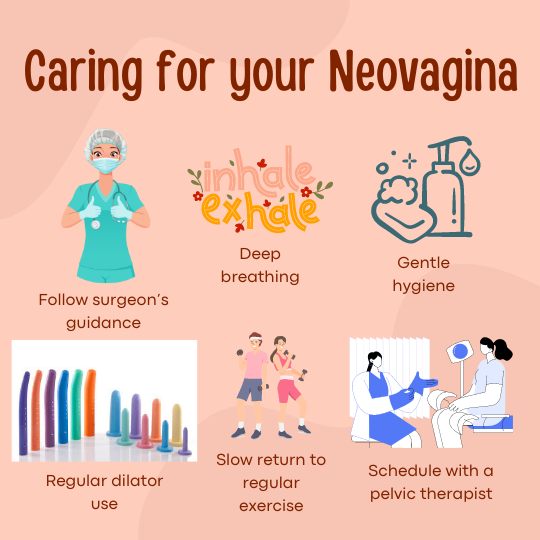What is a vaginoplasty? A vaginoplasty is the surgical creation of a neovagina. The procedure may be done as part of someone’s transition, gender-affirming care and typically involves inverting penile tissue. And it may be performed for those with MRKH syndrome or other vaginal agenesis (which is when external genitalia/vulva develops but the vagina and uterus do not). That procedure often involves using a part of the large intestine to create the neovagina.
Follow Your Surgeon’s Post-Op Instructions
First and foremost, following your surgeon’s post-operative instructions is vital. Each surgeon has a specific procedure and every surgery is unique, so your doctor’s team will give you instructions tailored to your individual needs. To optimize the healing of your neovagina, it is essential to follow the recommended guidelines closely. In the early post-op period, adhering to recommendations for wound care, activity restrictions, and the dilation protocol is critical. In most cases, post-op restrictions include: no swimming, bathing or submerging in water for at least 8 weeks. You will likely need to avoid strenuous exercise for 6 weeks and skip biking and swimming for about 3 months. Sitting may be uncomfortable, but sitting is usually OK; you may use a cushion to take pressure off the perineum. To help your tissues heal optimally avoid tobacco products, eat a balanced diet, and stay well hydrated.

Gentle Cleansing and Douching
You can shower on the day after vaginoplasty. You may feel lightheaded due to medications and decreased food intake, so you may want to use a shower chair to sit at first. It is important to use gentle, unscented soaps and pat the area and incisions dry. Ensure your hands are clean prior to touching or cleaning your genitals. Typically, gauze or other packing or a stenting device is inserted into the vagina during surgery; this will be removed in 5-7 days at your post-op visit. After removal and pending your surgeon’s clearance, you may begin cleaning internally. Typically, soap and water is recommended, and sometimes using a non-scented douche or water douche is advised. Listen to your doctor and nurses.
Dilate Regularly
Regular dilation is absolutely key in maintaining your neovagina and ensuring its width and depth. Your surgeon’s office will often provide you with a set of dilators. You will typically start as soon as the vaginal packing is removed at your first post-op visit. Most surgeons also have a specific dilation schedule, but you should expect to dilate daily and usually multiple times per day.

Pay Attention to Your Body
Vaginal discharge is expected and will likely be yellowish and brown in the first few weeks as your neovagina heals. You may also experience bleeding for about 8 weeks. Both discharge and bleeding should decrease over time; if it does not, please contact your doctor. Contact your doctor if you develop symptoms such as fever, body aches, chills, or severe pain.
Schedule a Visit with a Pelvic Floor Therapist
Working with a pelvic floor therapist can be crucial during your recovery. Physical therapists provide guidance, education, and support in working with vaginal dilators. In addition to dilators, targeted exercises to promote healing and mobility will be prescribed. Pelvic floor muscle retraining is essential to learning how to support your neovagina. Pelvic floor physical therapists can teach you how to relax and strengthen your muscles as indicated. Once you are cleared to be more active, your physical therapist will help build a specific program to help you reach your activity goals and get back to life!

